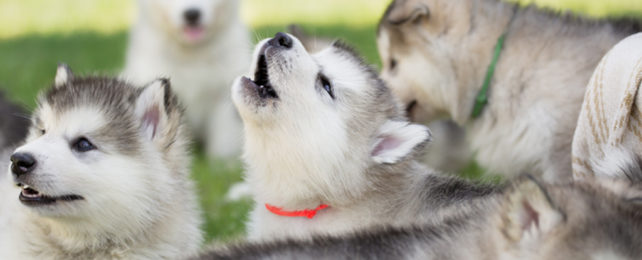Without convenient access to phones for pens for letter-writing, wolves must rely on howls to communicate long distances. These woeful wails allow the social mammals to maintain their territories as well as keep track of and stay in synchrony with other pack members.
While dogs (Canis familiaris) are descendants of wolves (Canis lupus), some dogs are not known to howl at all, whereas others, like sled dogs, will do so frequently.
A new study exposes family dogs to wolf howls to better understand why some of our canine companions no longer seem to bother with this seemingly important form of dog communication.
Eötvös Loránd University (ELTE) ethologist Fanni Lehoczki and colleagues put 68 purebred pet dogs to the test by observing their reactions to recordings of wild wolf howls, which can be seen in adorable clips below:

"According to our results, breeds which are genetically more similar to wolves ("ancient breeds"), are more prone to reply with their own howls to wolf howl playbacks," explains Lehoczki.
Young dogs, regardless of breed, responded moderately to hearing wolf howls, indicating most dogs, no matter the breed, are capable of howling. But the more closely related an adult dog is to a wolf, the more likely they were to howl back in response to a wolf wail.
"Interestingly, this genetic effect on howling occurs only among older dogs (greater than five years), for which an experience – or some age-related personality effect can be a plausible explanation," says ethologist Tamás Faragó also from ELTE in Hungary.
The reverse was seen for barking. Modern dog breeds barked more in response to howls than those dogs from older lineages.
This may mean that ancient breeds are responding to the howls by trying to communicate with the wolves, whereas modern breeds are trying to communicate with their owners instead, the team suggests.
What's more, those dogs that responded with howling showed greater stress behaviors, such as mouth licking, urinating, or shaking.
"This result on the stress behaviors may also confirm our hypothesis that more ancient breeds, due to their genetic relatedness, can process the information encoded in wolf howls better," the researchers write in their paper.
"Thus, ancient breeds of our study might become stressed by intruding on a pack's territory and use howling for the sake of avoidance, just as wolves do," elaborates Faragó.
Neutered males were more likely to howl in response than intact male dogs, but there was no difference between desexed and intact females.
"As neutered males are suggested to be more fearful, this result can be in line with our findings about responsiveness and more stressed behavior. Thus, the dog howl may mean, 'I am scared, don't come closer'," explains Lehoczki.
As this study only demonstrates correlations, there are other possible explanations that would need to be ruled out before these conclusions can be confirmed.
For example, older breeds tend to be working dog breeds, in which longer form communication may still prove useful, unlike newer breeds that tend to be pets.
A way to explore this further would be to include once domesticated dogs that are now wild in future studies to see if they've reverted to using this wailing form of communication more.
Dingoes (Canis dingo), which took an evolutionary path away from domestic dogs around 8,000 years ago, are known to howl extensively to find each other, just like wolves. This suggests environmental and social factors could still play a larger role in determining canine vocal behavior than genetics, explain Lehoczki and team.
"Our findings are among the first ones indicating that domestication can alter how animals process and react to others' vocalizations. This, ultimately, might help us better understand the evolution of vocal communication," the researchers conclude.
This research was published in Communications Biology.
